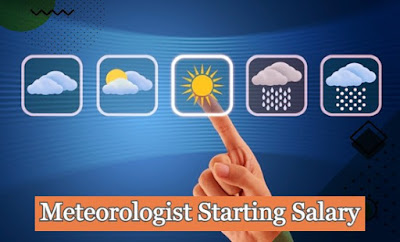Meteorologist Starting Salary in Every State (2021)
Starting Salary For Meteorologists (2021), Working Conditions, Training, Employment, Career and Nature of Work
EMPLOYMENT OUTLOOK:
Employment of meteorologists is expected to slow in the coming decline, increasing from 12,500 jobs in 2020 to 15,100 jobs in 2030. This slow increase is essentially thanks to the decline employed with the National Weather Service which employs nearly one-third of all meteorologists. Most employment growth are going to be found with colleges and universities, private consulting firms, and corporations analyzing emissions to enhance air quality.
NATURE OF WORK:
Meteorology is that the study of the atmosphere, the air that surrounds the world . Meteorologists study the atmosphere's physical characteristics, motions, and processes, and therefore the way the atmosphere affects the remainder of the environment. the simplest known application of this data is in forecasting the weather. Weather information and meteorological research are also applied in pollution control, agriculture, air and sea transportation, and therefore the study of trends within the earth's climate such a worldwide warming or ozone depletion.
WORKING CONDITIONS:
Meteorologists not doing forecasting work regular office hours. Those working in weather stations often work on night and do shift work. Weather stations are located at airports, in or near cities, and in isolated and remote areas. Meteorologists in small weather offices often work alone.
EDUCATION, TRAINING, QUALIFICATIONS:
The minimum educational requirement for meteorologists may be a bachelors' degree with a serious in meteorology or a clearly related field. A academic degree is important for conducting research and development; a Ph.D. is typically required for school teaching.
EARNINGS:
The average salary of meteorologists in nonsupervisory, and managerial positions with the Federal government in 2020 was $63,500. Meteorologists in the federal government with a bachelor's degree and no experience received starting salaries between $45,000 and $50,700 a year in 2020, depending on their college grades. Those with a master's degree started at $48,800 or $55,000; those with a Ph.D. degree started at $60,000 or $73,300.
TOP 5 BEST AND WORST THINGS ABOUT BEING A METEOROLOGY MAJOR
The Starting Salary For a Meteorologist in Every State (2021)
-Alabama $46,444-Alaska $49,555
-Arizona $43,429
-Arkansas $39,330
-California $51,486
-Colorado $53,560
-Connecticut $50,707
-Delaware $47,472
-Florida $48,529
-Georgia $44,414
-Hawaii $51,548
-Idaho $48,346
-Illinois $53,201
-Indiana $54,071
-Iowa $54,813
-Kansas $51,702
-Kentucky $51,280
-Louisiana $48,924
-Maine $48,982
-Maryland $49,247
-Massachusetts $51,732
-Michigan $47,868
-Minnesota $51,608
-Mississippi $48,053
-Missouri $52,034
-Montana $51,090
-Nebraska $50,124
-Nevada $52,257
-New Hampshire $56,862
-New Jersey $51,583
-New Mexico $45,325
-New York $51,452
-North Carolina $53,885
-North Dakota $57,218
-Ohio $53,430
-Oklahoma $51,229
-Oregon $55,354
-Pennsylvania $51,700
-Rhode Island $54,658
-South Carolina $51,444
-South Dakota $48,856
-Tennessee $48,294
-Texas $47,969
-Utah $43,811
-Vermont $52,358
-Virginia $53,010
-Washington $54,764
-West Virginia $45,517
-Wisconsin $50,731
-Wyoming $47,033











Comments
Post a Comment